Can More Environmental Information Disclosure Lead to Higher Eco-Efficiency? Evidence from China
Abstract
:1. Introduction
2. Methodology and Empirical Strategy
2.1. Measuring Environmental Information Disclosure in China
2.2. Measuring Eco-Efficiency with Meta-US-SBM Model
2.3. Empirical Strategy
3. Data Sources and Variable Definitions
- (1)
- Desirable output: The real gross domestic product (GDP) is chosen as good output with the data at constant 2008 prices, wherever applicable throughout this paper.
- (2)
- Undesirable outputs: Like most existing literature, environmental pollutants are treated as the bad outputs. In this study, four variables are selected according to data availability, namely, carbon dioxide emission which is estimated using the procedure suggested by Huang et al. [45], volume of industrial waste water discharged, volume of sulfur dioxide emission, and volume of industrial soot-dust removed. A potentially unfortunate consequence of the conventional DEA is that extreme values of inputs or outputs result in extreme weights such that some DMUs become “efficient by default” [46]. A widely applied approach to address this issue is generate an entropy-weighted index of multiple factors [47,48]. Thus, to alleviate the influence of extreme value, we employed the entropy weight method to generate a composite environmental pollution index (EPI) of these pollutants. The calculation process is provided in Appendix B.
- (3)
- Labor force: According to data availability, the total number of employees is used as proxy here.
- (4)
- Capital input: The method used frequently to estimate capital input is the perpetual inventory method [49,50]. The capital stock can be calculated as , where is the capital stock of city in year , and is the depreciation rate of fixed assets of city in year . We estimate capital stock based on the procedure provided by Ke and Xiang [51].
- (5)
- Land input: This paper adopts the construction land area as the proxy for land-use due to the accessibility of data [7].
- (6)
- Energy input: The primary energy consumption of 2008–2013 is extracted from Huang et al. [45], the primary energy consumption of the following two years is estimated using the same method they provided. Primary energy consumption is converted to standard coal equivalent (SCE) units—the standard energy metric used in Chinese energy statistics.
4. Empirical Results
4.1. Measuring Eco-Efficiency
4.2. Estimation Results
4.2.1. Statistical Tests of Unit Root and Granger Causality
4.2.2. Estimation Results of OLS and Quantile Regression
4.2.3. Estimation Results of Spatial Durbin Model
4.2.4. Supplementary Analysis: Panel Threshold Model
5. Conclusions
Acknowledgments
Author Contributions
Conflicts of Interest
Appendix A. List of 109 KEP Cities Included into the Sample
| Region | City | Region | City | Region | City |
|---|---|---|---|---|---|
| Eastern (49) | Jining | Changsha | |||
| Beijing Municipality | Tai’an | Zhuzhou | |||
| Tianjin Municipality | Rizhao | Xiangtan | |||
| Shijiazhuang | Guangzhou | Yueyang | |||
| Tangshan | Shaoguan | Changde | |||
| Qinhuangdao | Shenzhen | Zhangjiajie | |||
| Handan | Zhuhai | Western (29) | |||
| Baoding | Shantou | Hohhot | |||
| Shenyang | Foshan | Baotou | |||
| Dalian | Zhanjiang | Chifeng | |||
| Anshan | Dongguan | Nanning | |||
| Fushun | Zhongshan | Liuzhou | |||
| Benxi | Central (31) | Guilin | |||
| Shanghai Municipality | Taiyuan | Beihai | |||
| Nanjing | Datong | Chongqing Municipality | |||
| Wuxi | Yangquan | Chengdu | |||
| Xuzhou | Changzhi | Panzhihua | |||
| Changzhou | Linfen | Luzhou | |||
| Suzhou | Changchun | Mianyang | |||
| Nantong | Jilin | Yibin | |||
| Lianyungang | Harbin | Guiyang | |||
| Yangzhou | Qiqihar | Zunyi | |||
| Hangzhou | Daqing | Kunming | |||
| Ningbo | Mudanjiang | Qujing | |||
| Wenzhou | Hefei | Xi’an | |||
| Jiaxing | Wuhu | Tongchuan | |||
| Huzhou | Maanshan | Baoji | |||
| Shaoxing | Nanchang | Xianyang | |||
| Taizhou | Jiujiang | Yan’an | |||
| Fuzhou | Zhengzhou | Lanzhou | |||
| Xiamen | Kaifeng | Jinchang | |||
| Quanzhou | Luoyang | Xi’ning | |||
| Jinan | Pingdingshan | Yichuan | |||
| Qingdao | Anyang | Shizuishan | |||
| Zibo | Jiaozuo | Urumqi | |||
| Zaozhuang | Wuhan | Karamay | |||
| Yantai | Yichang | ||||
| Weifang | Jingzhou | ||||
Appendix B. Computation of Environmental Pollution Index
Appendix C. Data Sources
| Variable | Sources | |
| DEA model | Labor | China City Statistical Yearbook |
| Capital | China City Statistical Yearbook and China Statistical Yearbook | |
| Land | China City Statistical Yearbook | |
| Energy | GDP energy intensity (manually collected from various official documents) multiplied by GDP, China Energy Statistical Yearbook | |
| GDP | China City Statistical Yearbook | |
| EPI | China City Statistical Yearbook and China Environment Yearbook | |
| Econometric model | EE | Measured by Model (4) |
| PITI | Institute of Public & Environmental Affairs and Natural Resource Defense Council (2008–2016) | |
| PITI2 | Quadratic term of PITI | |
| POPD | China City Statistical Yearbook | |
| SFDI | China City Statistical Yearbook | |
| SIND | China City Statistical Yearbook | |
| WAGE | China City Statistical Yearbook | |
| TECH | China City Statistical Yearbook |
References
- Schaltegger, S.; Sturm, A. Ökologische Rationalität: Ansatzpunkte zur Ausgestaltung von ökologieorientierten Managementinstrumenten. Die Unternehmung 1990, 44, 273–290. [Google Scholar]
- Huang, J.; Xia, J.; Yu, Y.; Zhang, N. Composite eco-efficiency indicators for China based on data envelopment analysis. Ecol. Indic. 2018, 85, 674–697. [Google Scholar] [CrossRef]
- Lehni, M. Eco-Efficiency: Creating More Value with Less Impact; World Business Center for Sustainable Development: Geneva, Switzerland, 2000. [Google Scholar]
- Mickwitz, P.; Melanen, M.; Rosenström, U.; Seppälä, J. Regional eco-efficiency indicators-a participatory approach. J. Clean. Prod. 2006, 14, 1603–1611. [Google Scholar] [CrossRef]
- Zhang, B.; Bi, J.; Fan, Z.; Ge, J. Eco-efficiency analysis of industrial system in China: A data envelopment analysis approach. Ecol. Econ. 2008, 68, 306–316. [Google Scholar] [CrossRef]
- Huppes, G.; Ishikawa, M. A Framework for Quantified Eco-efficiency Analysis. J. Ind. Ecol. 2010, 9, 25–41. [Google Scholar] [CrossRef]
- Picazo-Tadeo, A.J.; Gómez-Limón, J.A.; Reig-Martínez, E. Assessing farming eco-efficiency: A data envelopment analysis approach. J. Environ. Manag. 2011, 92, 1154–1164. [Google Scholar] [CrossRef] [PubMed]
- Huang, J.; Yang, X.; Cheng, G.; Wang, S. A comprehensive eco-efficiency model and dynamics of regional eco-efficiency in China. J. Clean. Prod. 2014, 67, 228–238. [Google Scholar] [CrossRef]
- Zhang, N.; Kong, F.; Yu, Y. Measuring ecological total-factor energy efficiency incorporating regional heterogeneities in China. Ecol. Indic. 2015, 51, 165–172. [Google Scholar] [CrossRef]
- Arabi, B.; Munisamy, S.; Emrouznejad, A.; Toloo, M.; Ghazizadeh, M.S. Eco-efficiency considering the issue of heterogeneity among power plants. Energy 2016, 111, 722–735. [Google Scholar] [CrossRef]
- Masternak-Janus, A.; Rybaczewska-Błażejowska, M. Comprehensive Regional Eco-Efficiency Analysis Based on Data Envelopment Analysis: The Case of Polish Regions. J. Ind. Ecol. 2017, 21, 180–190. [Google Scholar] [CrossRef]
- Al-Tuwaijri, S.A.; Christensen, T.E.; Ii, K.E.H. The relations among environmental disclosure, environmental performance, and economic performance: A simultaneous equations approach. Account. Org. Soc. 2004, 29, 447–471. [Google Scholar] [CrossRef]
- Clarkson, P.M.; Li, Y.; Richardson, G.D.; Vasvari, F.P. Revisiting the relation between environmental performance and environmental disclosure: An empirical analysis. Account. Org. Soc. 2008, 33, 303–327. [Google Scholar] [CrossRef]
- Cho, C.H.; Patten, D.M. The role of environmental disclosures as tools of legitimacy: A research note. Account. Org. Soc. 2007, 32, 639–647. [Google Scholar] [CrossRef]
- Villiers, C.D.; van Staden, C.J. Can less environmental disclosure have a legitimising effect? Evidence from Africa. Account. Org. Soc. 2006, 31, 763–781. [Google Scholar] [CrossRef]
- Berthelot, S.; Cormier, D.; Magnan, M. Environmental disclosure research: Review and synthesis. J. Account. Lit. 2003, 22, 1–44. [Google Scholar]
- Liu, Z.G.; Liu, T.T.; McConkey, B.G.; Li, X. Empirical analysis on environmental disclosure and environmental performance level of listed steel companies. Energy Procedia 2011, 5, 2211–2218. [Google Scholar] [CrossRef]
- Sutantoputra, A.W.; Lindorff, M.; Johnson, E.P. The relationship between environmental performance and environmental disclosure. Australas. J. Environ. Manag. 2012, 19, 51–65. [Google Scholar] [CrossRef]
- Zhang, L.; Mol, A.P.J.; He, G. Transparency and information disclosure in China’s environmental governance. Curr. Opin. Environ. Sustian. 2016, 18, 17–24. [Google Scholar] [CrossRef]
- Li, Z.; Ouyang, X.; Du, K.; Zhao, Y. Does government transparency contribute to improved eco-efficiency performance? An empirical study of 262 cities in China. Energy Policy 2017, 110, 79–89. [Google Scholar] [CrossRef]
- Yook, K.H.; Song, H.; Patten, D.M.; Kim, I.W. The disclosure of environmental conservation costs and its relation to eco-efficiency: Evidence from Japan. Sustian. Account. Manag. Policy J. 2017, 8, 20–42. [Google Scholar] [CrossRef]
- Darrell, W.; Schwartz, B.N. Environmental disclosures and public policy pressure. J. Account. Public Policy 1997, 16, 125–154. [Google Scholar] [CrossRef]
- Tilling, M.V. Some thoughts on legitimacy theory in social and environmental accounting. Soc. Environ. Account. J. 2004, 24, 3–7. [Google Scholar] [CrossRef]
- Wei, Q.; Schaltegger, S. Revisiting carbon disclosure and performance: Legitimacy and management views. Br. Account. Rev. 2017, 49, 365–379. [Google Scholar]
- Hummel, K.; Schlick, C. The relationship between sustainability performance and sustainability disclosure—Reconciling voluntary disclosure theory and legitimacy theory. J. Account. Public Policy 2016, 35, 455–476. [Google Scholar] [CrossRef]
- Battese, G.E.; Rao, D.S.P.; O’Donnell, C.J. A metafrontier production function for estimation of technical efficiencies and technology gaps for firms operating under different technologies. J. Prod. Anal. 2004, 21, 91–103. [Google Scholar] [CrossRef]
- Andersen, P.; Petersen, N.C. A procedure for ranking efficient units in data envelopment analysis. Manag. Sci. 1993, 39, 1261–1264. [Google Scholar] [CrossRef]
- Wang, A. Explaining Environmental Information Disclosure in China. Ecol. Law Q. 2017–2018, 44. Forthcoming; UCLA School of Law, Public Law Research Paper No. 17-14. Available online: https://ssrn.com/abstract=2956069 (accessed on 20 April 2017).
- Koenker, R.; Bassett, G., Jr. Regression quantiles. Econometrica 1978, 46, 33–50. [Google Scholar] [CrossRef]
- Canay, I.A. A simple approach to quantile regression for panel data. Econ. J. 2011, 14, 368–386. [Google Scholar] [CrossRef]
- Zhang, Y.J.; Peng, H.R.; Liu, Z.; Tan, W. Direct energy rebound effect for road passenger transport in China: A dynamic panel quantile regression approach. Energy Policy 2015, 87, 303–313. [Google Scholar] [CrossRef]
- Rejeb, A.B.; Arfaoui, M. Financial market interdependencies: A quantile regression analysis of volatility spillover. Res. Int. Bus. Financ. 2016, 36, 140–157. [Google Scholar] [CrossRef]
- Moutinho, V.; Madaleno, M.; Robaina, M. The economic and environmental efficiency assessment in EU cross-country: Evidence from DEA and quantile regression approach. Ecol. Indic. 2017, 78, 85–97. [Google Scholar] [CrossRef]
- Agyiretettey, F.; Ackah, C.G.; Asuman, D. An Unconditional Quantile Regression Based Decomposition of Spatial Welfare Inequalities in Ghana. J. Dev. Stud. 2017, 1–20. [Google Scholar] [CrossRef]
- Anselin, L. Lagrange multiplier test diagnostics for spatial dependence and spatial heterogeneity. Geogr. Anal. 1988, 20, 1–17. [Google Scholar] [CrossRef]
- LeSage, J.P. An Introduction to Spatial Econometrics; Revue D’économie Industrielle; CRC Press: Boca Raton, FL, USA, 2008; pp. 19–44. [Google Scholar]
- Elhorst, J.P. Spatial Econometrics: From Cross-Sectional Data to Spatial Panels; Springer Brief in Regional Science; Springer: Berlin/Heidelberg, Germany, 2014. [Google Scholar]
- Halleck Vega, S.; Elhorst, J.P. The SLX model. J. Reg. Sci. 2015, 55, 339–363. [Google Scholar] [CrossRef]
- Case, A.C.; Rosen, H.S.; Hines, J.R. Budget spillovers and fiscal policy interdependence: Evidence from the states. J. Public Econ. 1993, 52, 285–307. [Google Scholar] [CrossRef]
- Fredriksson, P.G.; Millimet, D.L. Strategic interaction and the determination of environmental policy across US states. J. Urban Econ. 2002, 51, 101–122. [Google Scholar] [CrossRef]
- Lv, Z.; Xu, T. A panel data quantile regression analysis of the impact of corruption on tourism. Curr. Issues Tour. 2016, 20, 1–14. [Google Scholar] [CrossRef]
- CEY. China Environment Yearbooks; China Environment Yearbook Press: Beijing, China, 2005–2016. [Google Scholar]
- CESY. China Energy Statistical Yearbooks; China Statistics Press: Beijing, China, 2005–2016.
- CCSY. China City Statistical Yearbooks; China Statistics Press: Beijing, China, 2005–2016.
- Huang, J.; Yu, Y.; Ma, C. Energy Efficiency Convergence in China: Catch-Up, Lock-In and Regulatory Uniformity. Environ. Resour. Econ. 2017, 1–24. [Google Scholar] [CrossRef]
- Asmild, M.; Zhu, M. Controlling for the use of extreme weights in bank efficiency assessments during the financial crisis. Eur. J. Oper. Res. 2016, 251, 999–1015. [Google Scholar] [CrossRef]
- Bian, Y.; Yang, F. Resource and environment efficiency analysis of provinces in China: A DEA approach based on Shannon’s entropy. Energy Policy 2010, 38, 1909–1917. [Google Scholar] [CrossRef]
- Ludovisi, A. Effectiveness of entropy-based functions in the analysis of ecosystem state and development. Ecol. Indic. 2014, 36, 617–623. [Google Scholar] [CrossRef]
- Zhang, J. Estimation of China’s provincial capital stock (1952-2004) with applications. J. Chin. Econ. Bus. Stud. 2008, 6, 177–196. [Google Scholar] [CrossRef]
- Berlemann, M.; Wesselhöft, J.E. Estimating aggregate capital stocks using the perpetual inventory method. Rev. Econ. 2014, 65, 1–34. [Google Scholar] [CrossRef]
- Ke, S.; Xiang, J. Estimation of the Fixed Capital Stocks in Chinese Cities for 1996-2009. Stat. Res. 2012, 29, 1–10. (In Chinese) [Google Scholar]
- Magrini, S. Analysing Convergence through the Distribution Dynamics Approach: Why and How; Working Paper Number 13/WP/2007; Department of Economics Ca’Foscari, University of Venice: Venice, Italy, 2007. [Google Scholar]
- Levin, A.; Lin, C.F.; Chu, C.S.J. Unit root tests in panel data: Asymptotic and finite-sample properties. J. Econ. 2002, 108, 1–24. [Google Scholar] [CrossRef]
- Granger, C.W.J.; Huang, L.L. Evaluation of Panel Data Models: Some Suggestions from Time Series; Department of Economics, University of California: San Diego, CA, USA, 1997; 29p. [Google Scholar]
- Emirmahmutoglu, F.; Kose, N. Testing for Granger causality in heterogeneous mixed panels. Econ. Model. 2011, 28, 870–876. [Google Scholar] [CrossRef]
- Fang, Z.; Chen, Y. Human capital and energy in economic growth-Evidence from Chinese provincial data. Energy Econ. 2017, 68, 340–358. [Google Scholar] [CrossRef]
- Ciccone, A.; Hall, R.E. Productivity and the density of economic activity. Am. Econ. Rev. 1996, 86, 54–70. [Google Scholar]
- Moran, P.A.P. Notes on continuous stochastic phenomena. Biometrika 1950, 37, 17–23. [Google Scholar] [CrossRef] [PubMed]
- Geary, R.C. The contiguity ratio and statistical mapping. Inc. Stat. 1954, 5, 115–146. [Google Scholar] [CrossRef]
- Qian, S.S. Ecological threshold and environmental management: A note on statistical methods for detecting thresholds. Ecol. Indic. 2014, 38, 192–197. [Google Scholar] [CrossRef]
- LeSage, J.P.; Pace, R.K. The Biggest Myth in Spatial Econometrics. Econometrics 2014, 2, 217–249. [Google Scholar] [CrossRef]
- Hansen, B.E. Threshold effects in non-dynamic panels: Estimation, testing, and inference. J. Econ. 1999, 93, 345–368. [Google Scholar] [CrossRef]
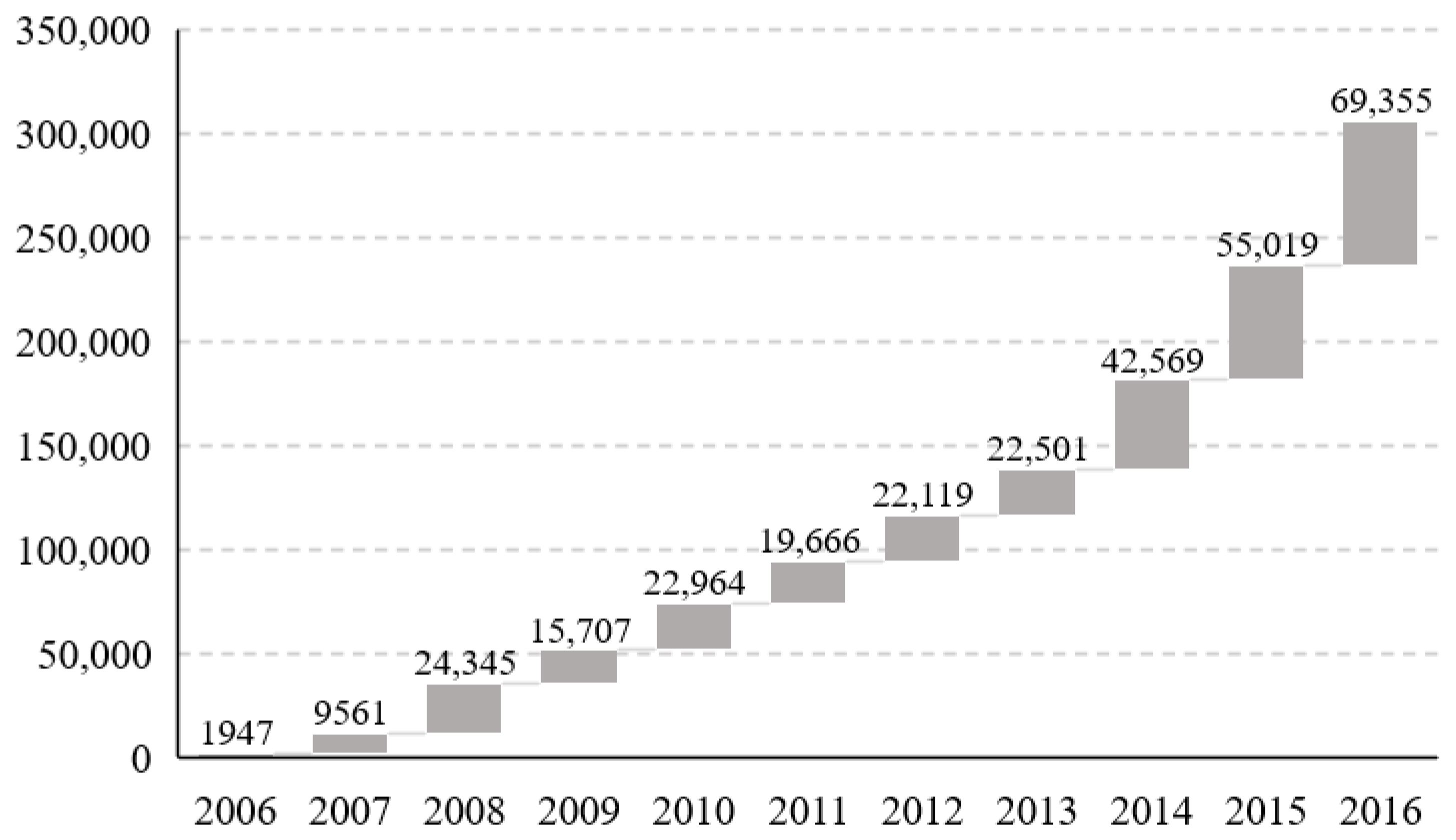
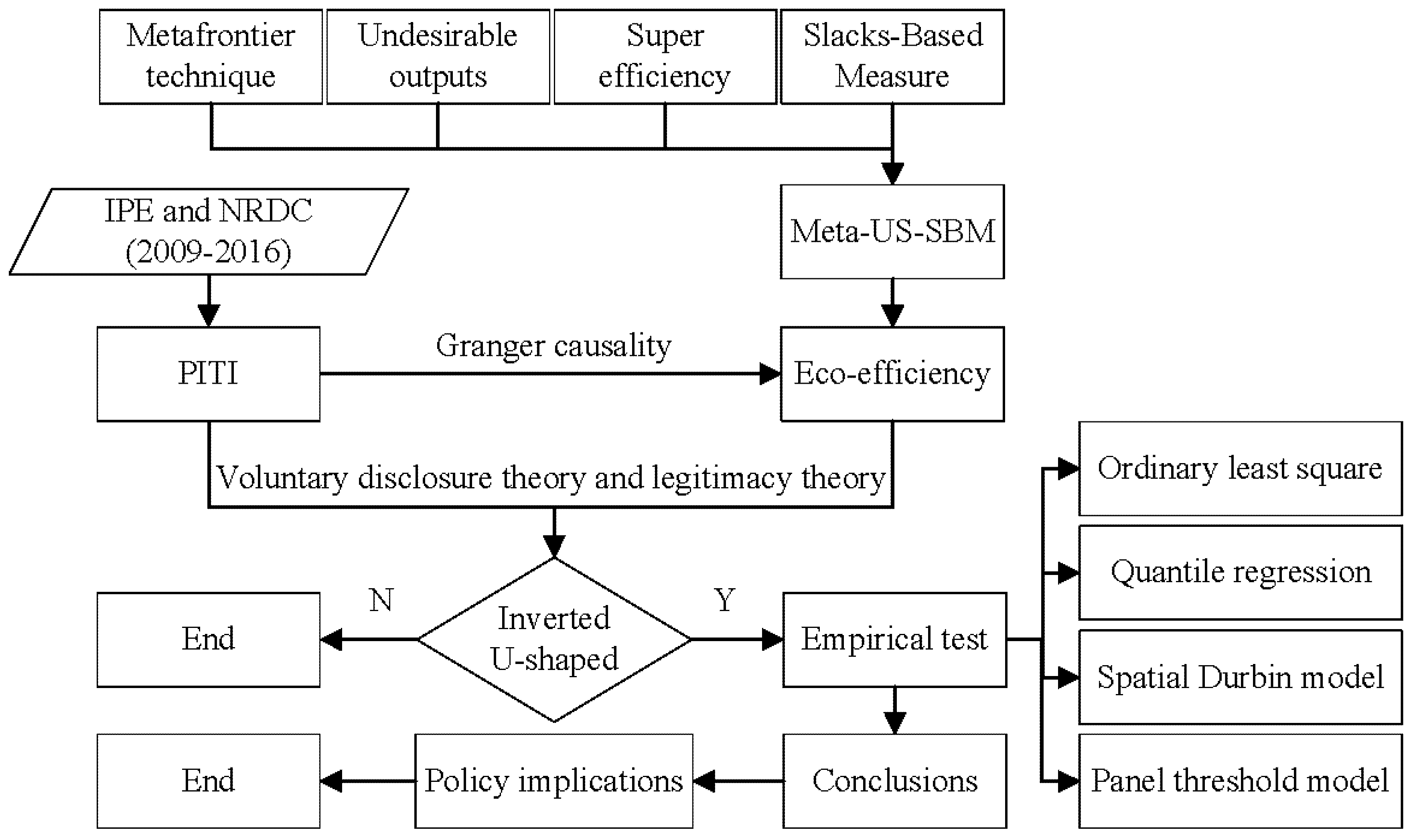
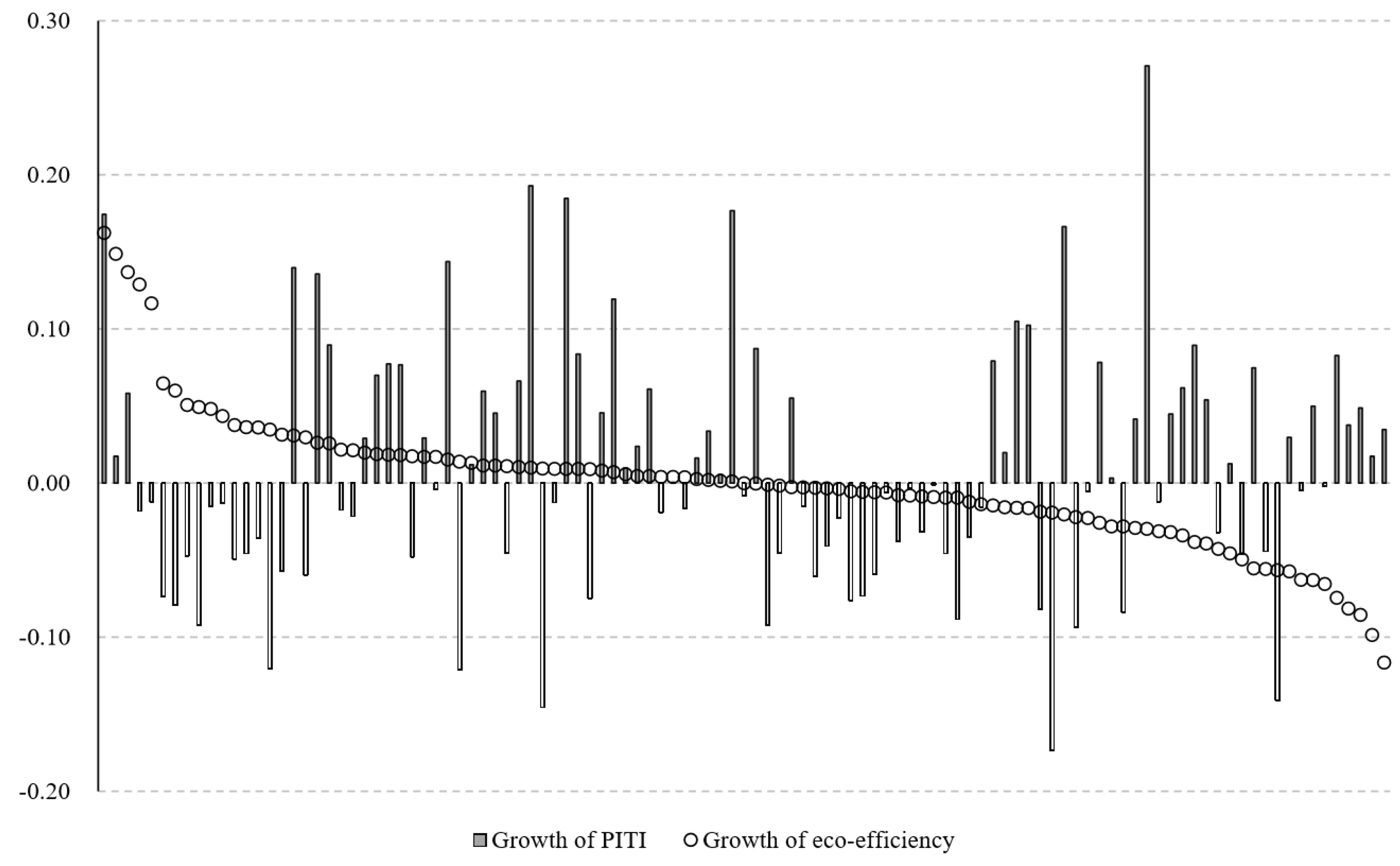
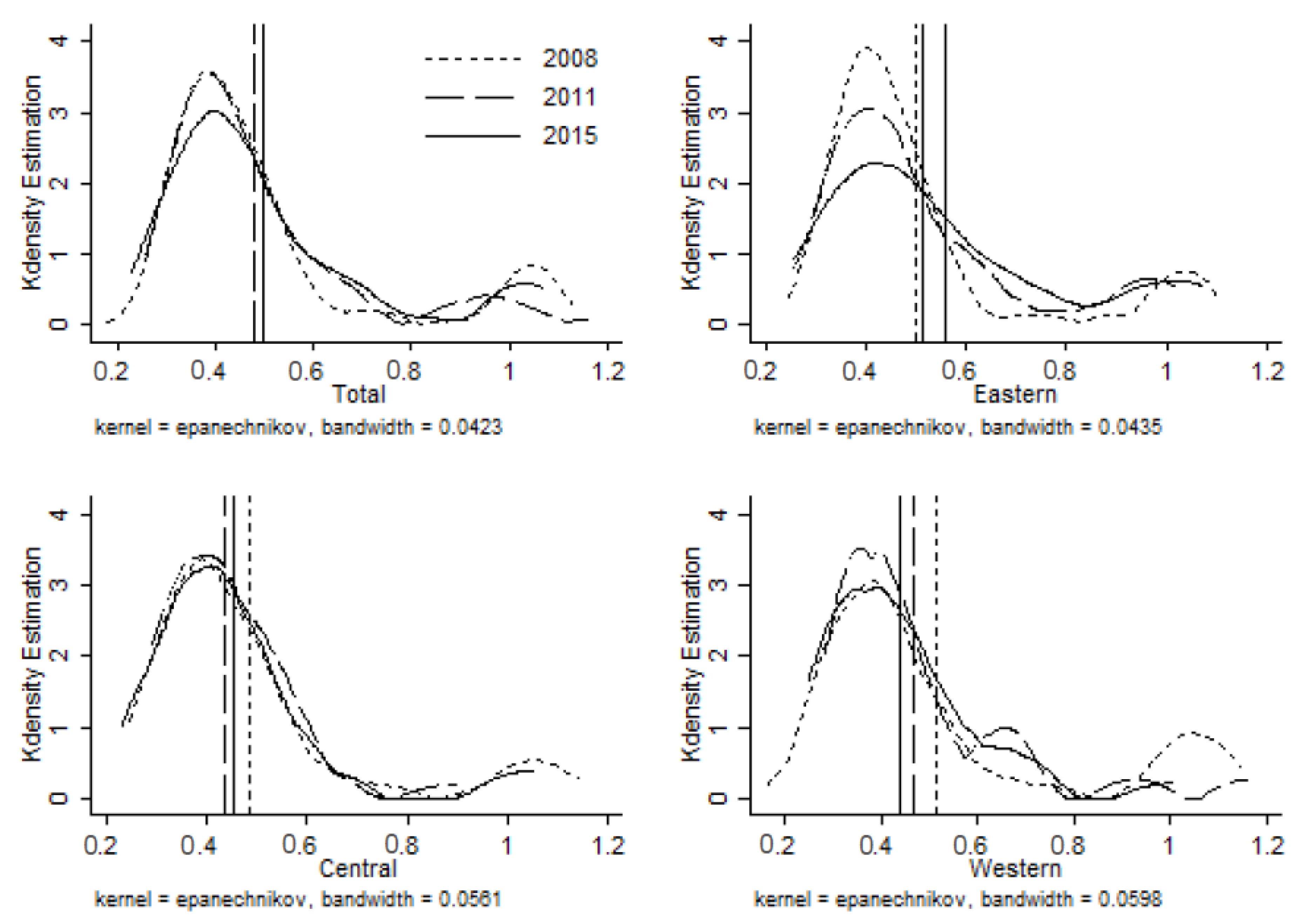

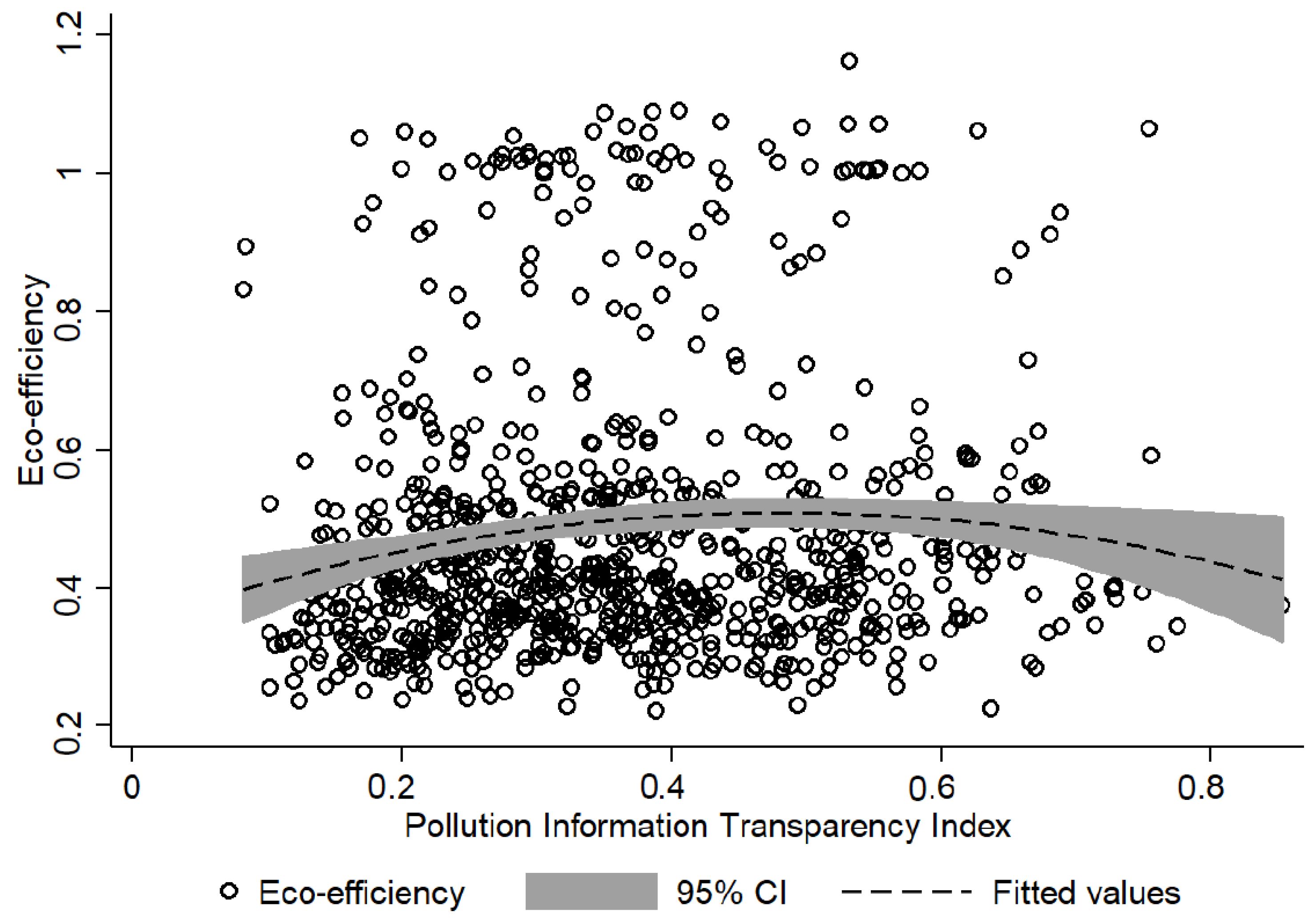

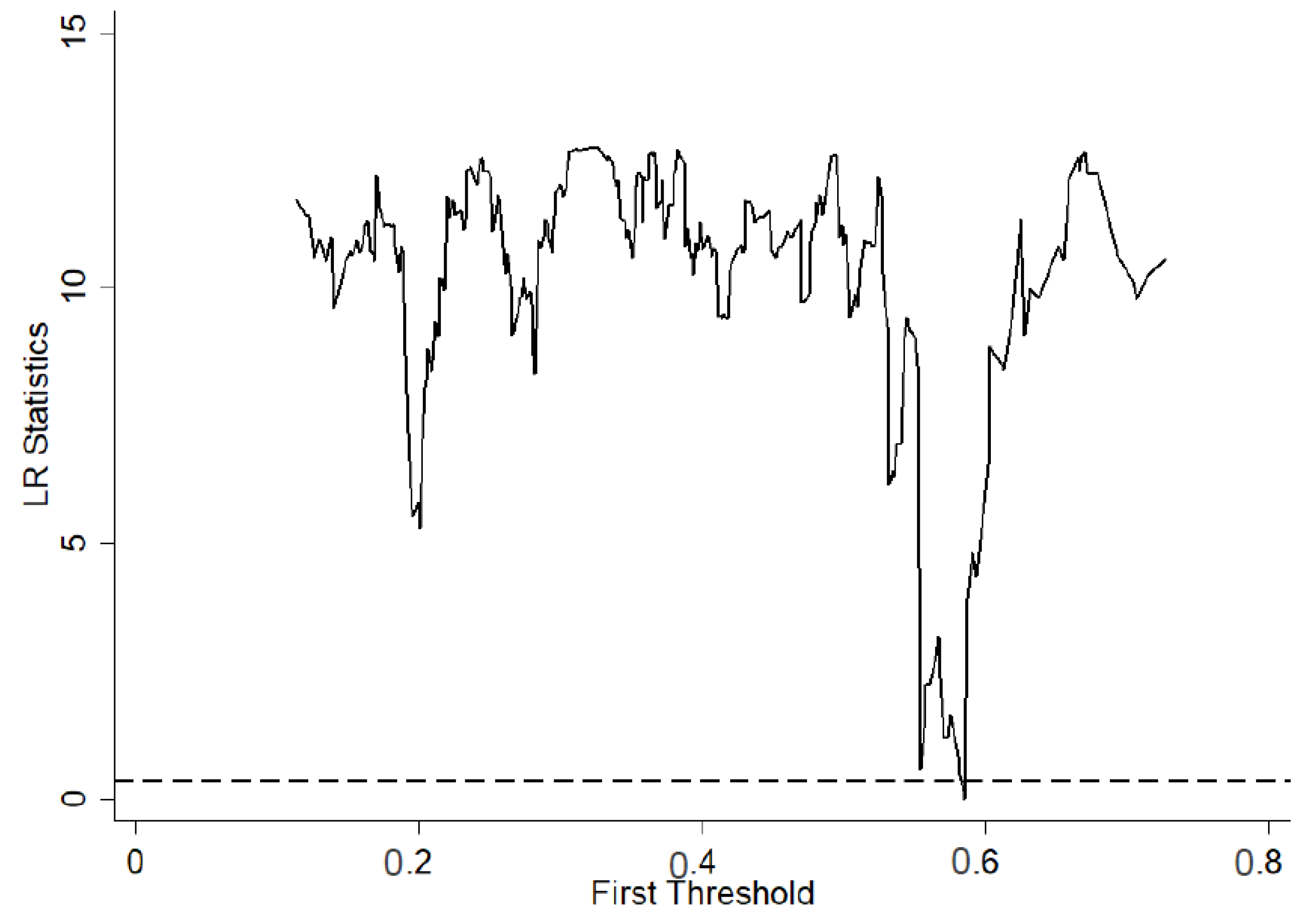
| Variable | Obs. | Unit | Mean | Std. Dev. | Min | Max | |
|---|---|---|---|---|---|---|---|
| DEA model | Labor | 872 | 10,000 persons | 88.9464 | 107.8553 | 6.7070 | 986.8700 |
| Capital | 872 | 100 million RMB | 2660.0000 | 2740.0000 | 63.6000 | 22,000.0000 | |
| Land | 872 | km2 | 13,820.4800 | 13,256.3700 | 1573.0000 | 90,659.0000 | |
| Energy | 872 | Tons of SCE | 2561.7100 | 1978.5020 | 147.6930 | 11,719.5000 | |
| GDP | 872 | 100 million RMB | 3180.0000 | 3350.0000 | 130.0000 | 25,000.0000 | |
| EPI | 872 | - | 1.1468 | 1.0351 | 0.0993 | 16.8606 | |
| Econometric model | EE | 872 | - | 0.4834 | 0.1999 | 0.2210 | 1.1630 |
| PITI | 872 | - | 0.3680 | 0.1553 | 0.0830 | 0.8530 | |
| PITI2 | 872 | - | 0.1595 | 0.1309 | 0.0069 | 0.7276 | |
| POPD | 872 | 1000 persons/km2 | 0.5456 | 0.3919 | 0.0388 | 2.6481 | |
| SFDI | 872 | - | 0.2002 | 0.2302 | 0.0000 | 1.4432 | |
| SIND | 872 | - | 0.5183 | 0.1012 | 0.1974 | 0.9097 | |
| WAGE | 872 | - | 10.6216 | 0.3189 | 9.6542 | 11.6358 | |
| TECH | 872 | - | 0.0202 | 0.0159 | 0.0016 | 0.0986 |
| EE | PITI | PITI2 | POPD | SFDI | SIND | WAGE | TECH | |
|---|---|---|---|---|---|---|---|---|
| EE | 1.0000 | |||||||
| PITI | 0.0760 ** | 1.0000 | ||||||
| PITI2 | 0.0530 | 0.9770 *** | 1.0000 | |||||
| POPD | 0.3380 *** | 0.0320 | 0.035 | 1.0000 | ||||
| SFDI | 0.3480 *** | 0.0200 | 0.035 | 0.4620 *** | 1.0000 | |||
| SIND | 0.0240 | 0.0330 | 0.033 | −0.1450 *** | −0.0760 ** | 1.0000 | ||
| WAGE | 0.1250 *** | −0.0440 | −0.042 | 0.2060 *** | 0.2620 *** | −0.1550 *** | 1.0000 | |
| TECH | −0.1320 *** | −0.0780 ** | −0.081 ** | −0.0310 | −0.0650 * | −0.2740 *** | 0.2420 *** | 1.0000 |
| Level | ||||
|---|---|---|---|---|
| Intercept | Intercept and Trend | |||
| EE | −0.6969 *** | (−14.2660) | −1.5904 *** | (−59.1930) |
| PITI | −1.1365 *** | (−25.8790) | −1.7020 *** | (−42.6810) |
| PITI2 | −1.1487 *** | (−25.3460) | −1.8994 *** | (−45.2540) |
| POPD | −0.2337 *** | (−13.0780) | −1.3823 *** | (−39.5360) |
| SFDI | −0.3729 *** | (−10.7740) | −1.4691 *** | (−65.3220) |
| SIND | −0.4174 *** | (−22.7920) | −0.6354 *** | (−28.7230) |
| TECH | −0.7564 *** | (−18.9200) | −1.4770 *** | (−38.8110) |
| (1) | (2) | (3) | (4) | (5) | (6) | (7) | |
|---|---|---|---|---|---|---|---|
| Variable | Pool OLS | FE | Quantile Regression | ||||
| 10th | 25th | 50th | 75th | 90th | |||
| PITI | 0.7895 *** | 0.1974 ** | 0.1975 *** | 0.0624 | 0.1320 | 0.1915 *** | 1.3186 *** |
| (4.8492) | (2.0427) | (4.7273) | (1.5918) | (1.1037) | (6.7093) | (2.9324) | |
| PITI2 | −0.8701 *** | −0.2816 ** | −0.2633 *** | −0.0937 ** | −0.1389 | −0.2109 *** | −1.6194 *** |
| (−4.5736) | (−2.3647) | (−3.1906) | (−2.0697) | (−0.9986) | (−5.8970) | (−3.0553) | |
| POPD | 0.1129 *** | 0.4364 *** | 0.0776 *** | 0.0526 *** | 0.1500 *** | 0.0719 *** | 0.1049 *** |
| (5.5408) | (2.7121) | (9.3876) | (4.4373) | (5.7884) | (13.3616) | (3.3808) | |
| SFDI | 0.2051 *** | −0.1866 ** | 0.0625 *** | 0.1769 *** | 0.1330 *** | 0.3902 *** | −0.0867 |
| (5.3410) | (−2.2589) | (3.3452) | (23.1193) | (4.2489) | (55.3353) | (−0.6546) | |
| SIND | 0.1025 | −0.1461 | −0.0323 ** | 0.1634 *** | 0.1303 *** | 0.2738 *** | −0.2644 |
| (1.0763) | (−1.0325) | (−2.1717) | (10.0562) | (8.8133) | (11.3106) | (−1.4661) | |
| WAGE | 0.0347 | 0.1563 ** | −0.0016 | −0.0421 *** | 0.0713 *** | 0.0583 *** | 0.3859 ** |
| (1.5854) | (2.5749) | (−0.2175) | (−4.7291) | (3.6603) | (17.6245) | (2.3921) | |
| TECH | −1.3456 *** | 0.8168 | −0.7918 *** | −0.0686 | −0.9622 *** | −1.3632 *** | −4.6986 *** |
| (−3.1873) | (0.6997) | (−4.2873) | (−1.0968) | (−19.6825) | (−19.6231) | (−5.7829) | |
| (1) | (2) | (3) | (4) | (5) | (6) | (7) | |
|---|---|---|---|---|---|---|---|
| Variable | Pool OLS | FE | Quantile Regression | ||||
| 10th | 25th | 50th | 75th | 90th | |||
| PITI * | 0.4537 | 0.3505 | 0.3750 | NA | NA | 0.4540 | 0.4071 |
| (1) | (2) | (3) | (4) | |||||
|---|---|---|---|---|---|---|---|---|
| Variable | Inverse Distance Matrix | Economic-Based Matrix | Inverse Distance and Economic-Based Matrix | Population-Distance-Based Matrix | ||||
| PITI | 0.1685 * | (1.9046) | 0.2108 ** | (2.4150) | 0.1915 ** | (2.1882) | 0.1691 * | (1.9040) |
| PITI2 | −0.2500 ** | (−2.4171) | −0.2976 *** | (−2.9256) | −0.2748 *** | (−2.6943) | −0.2491 ** | (−2.3989) |
| POPD | 0.4658 *** | (5.5019) | 0.3797 *** | (4.5812) | 0.4106 *** | (4.7467) | 0.4798 *** | (5.6465) |
| SFDI | −0.1813 *** | (−3.2755) | −0.1582 *** | (−2.8477) | −0.1473 *** | (−2.6019) | −0.1818 *** | (−3.2685) |
| SIND | −0.0553 | (−0.4570) | −0.0884 | (−0.8185) | −0.0193 | (−0.1712) | −0.0516 | (−0.4259) |
| WAGE | 0.1757 *** | (4.1175) | 0.1572 *** | (3.7600) | 0.1671 *** | (3.9253) | 0.1753 *** | (4.0813) |
| TECH | 1.4093 * | (1.9363) | 0.6506 | (0.9260) | 0.8236 | (1.1602) | 1.4065* | (1.9320) |
| W*PITI | −1.0690 | (−1.3788) | −0.2906 | (−1.0696) | −0.2466 | (−1.0178) | −1.0073 | (−1.2991) |
| W*PITI2 | 1.2897 | (1.3785) | 0.3217 | (0.9725) | 0.2850 | (0.9861) | 1.2622 | (1.3485) |
| W*POPD | −1.8345 *** | (−3.5051) | 0.9066 *** | (2.8570) | 0.1937 | (0.7843) | −1.6461 *** | (−3.2014) |
| W*SFDI | −1.1522 *** | (−3.0795) | −0.1416 | (−1.1196) | −0.0606 | (−0.4617) | −1.0277 *** | (−2.8493) |
| W*SIND | −0.4715 | (−0.6836) | −0.4337 | (−1.4829) | −0.7373 *** | (−2.7542) | −0.6766 | (−0.9785) |
| W*WAGE | −0.0255 | (−0.0793) | −0.0056 | (−0.0385) | 0.0480 | (0.3938) | 0.1046 | (0.3300) |
| W*TECH | 5.1552 | (0.8568) | 3.1770 | (1.2561) | −1.9314 | (−0.9205) | 4.5939 | (0.7712) |
| ρ | −0.3483 * | (−1.9563) | 0.1666 ** | (2.2582) | 0.1375 ** | (2.1791) | −0.2645 | (−1.5302) |
| R-squared | 0.0191 | 0.0423 | 0.0869 | 0.0099 | ||||
| Log L | 1033.5962 | 1033.4107 | 1029.4746 | 1031.9667 | ||||
| AIC | −2035.1920 | −2034.8210 | −2026.9490 | −2031.9330 | ||||
| BIC | −1958.8600 | −1958.4890 | −1950.6170 | −1955.6010 | ||||
| (1) | (2) | (3) | (4) | |||||
|---|---|---|---|---|---|---|---|---|
| Inverse Distance Matrix | Economic-Based Matrix | Inverse Distance and Economic-Based Matrix | Population-Distance-Based Matrix | |||||
| Panel A: Direct effect | ||||||||
| PITI | 0.1800 ** | (1.9871) | 0.2082 ** | (2.3097) | 0.1899 ** | (2.1024) | 0.1783 ** | (1.9622) |
| PITI2 | −0.2649 ** | (−2.5028) | −0.2959 *** | (−2.8088) | −0.2741 *** | (−2.5963) | −0.2616 ** | (−2.4611) |
| POPD | 0.4883 *** | (5.9892) | 0.4090 *** | (5.1280) | 0.4239 *** | (5.1619) | 0.4980 *** | (6.0934) |
| SFDI | −0.1730 *** | (−3.1495) | −0.1614 *** | (−2.9429) | −0.1488 *** | (−2.6799) | −0.1758 *** | (−3.1944) |
| SIND | −0.0507 | (−0.4244) | −0.0969 | (−0.9266) | −0.0335 | (−0.3095) | −0.0465 | (−0.3910) |
| WAGE | 0.1786 *** | (4.2069) | 0.1596 *** | (3.8088) | 0.1704 *** | (4.0470) | 0.1771 *** | (4.1551) |
| TECH | 1.3781* | (1.8308) | 0.7295 | (0.9827) | 0.7914 | (1.0570) | 1.3854 * | (1.8366) |
| Panel B: Indirect effect | ||||||||
| PITI | −0.8717 | (−1.5727) | −0.3108 | (−1.0134) | −0.2591 | (−0.9751) | −0.8677 | (−1.4686) |
| PITI2 | 1.0767 | (1.5856) | 0.3398 | (0.9003) | 0.2974 | (0.9307) | 1.1072 | (1.5275) |
| POPD | −1.4978 *** | (−3.4695) | 1.1562 *** | (3.0592) | 0.2873 | (1.0544) | −1.4168 *** | (−3.1491) |
| SFDI | −0.8237 *** | (−2.8677) | −0.2014 | (−1.4019) | −0.0942 | (−0.6542) | −0.7901 *** | (−2.6734) |
| SIND | −0.3080 | (−0.5611) | −0.4978 | (−1.3436) | −0.8190 ** | (−2.5141) | −0.4961 | (−0.8515) |
| WAGE | −0.0809 | (−0.3491) | 0.0109 | (0.0652) | 0.0703 | (0.5358) | 0.0307 | (0.1265) |
| TECH | 3.5203 | (0.8003) | 4.0135 | (1.3125) | −2.0145 | (−0.8245) | 3.4081 | (0.7318) |
| Panel C: Total effect | ||||||||
| PITI | −0.6918 | (−1.2231) | −0.1026 | (−0.3102) | −0.0693 | (−0.2376) | −0.6894 | (−1.1409) |
| PITI2 | 0.8118 | (1.1691) | 0.0439 | (0.1080) | 0.0234 | (0.0666) | 0.8456 | (1.1385) |
| POPD | −1.0095 ** | (−2.4073) | 1.5652 *** | (4.0387) | 0.7112 *** | (2.6432) | −0.9189 ** | (−2.1030) |
| SFDI | −0.9967 *** | (−3.5217) | −0.3628 ** | (−2.3770) | −0.2429 | (−1.6374) | −0.9659 *** | (−3.2980) |
| SIND | −0.3588 | (−0.7073) | −0.5947 | (−1.5275) | −0.8525 *** | (−2.6199) | −0.5426 | (−1.0005) |
| WAGE | 0.0977 | (0.4248) | 0.1705 | (0.9478) | 0.2407 * | (1.7108) | 0.2079 | (0.8618) |
| TECH | 4.8984 | (1.0756) | 4.7430 | (1.4442) | −1.2231 | (−0.4537) | 4.7935 | (0.9945) |
| (1) | (2) | (3) | (4) | |
|---|---|---|---|---|
| Variable | Inverse Distance Matrix | Economic-Based Matrix | Inverse Distance and Economic-Based Matrix | Population-Distance-Based Matrix |
| PITI * | 0.3370 | 0.3542 | 0.3484 | 0.3394 |
| Test for Single Threshold Effects | Test for Double Threshold Effects | |||||
|---|---|---|---|---|---|---|
| Threshold Values | F | p-Value | Double Threshold Values | F | p-Value | |
| 0.5850 | 12.8600 | 0.0495 | 0.5710 | 0.6030 | 0.2200 | 1.0000 |
© 2018 by the authors. Licensee MDPI, Basel, Switzerland. This article is an open access article distributed under the terms and conditions of the Creative Commons Attribution (CC BY) license (http://creativecommons.org/licenses/by/4.0/).
Share and Cite
Yu, Y.; Huang, J.; Luo, N. Can More Environmental Information Disclosure Lead to Higher Eco-Efficiency? Evidence from China. Sustainability 2018, 10, 528. https://0-doi-org.brum.beds.ac.uk/10.3390/su10020528
Yu Y, Huang J, Luo N. Can More Environmental Information Disclosure Lead to Higher Eco-Efficiency? Evidence from China. Sustainability. 2018; 10(2):528. https://0-doi-org.brum.beds.ac.uk/10.3390/su10020528
Chicago/Turabian StyleYu, Yantuan, Jianhuan Huang, and Nengsheng Luo. 2018. "Can More Environmental Information Disclosure Lead to Higher Eco-Efficiency? Evidence from China" Sustainability 10, no. 2: 528. https://0-doi-org.brum.beds.ac.uk/10.3390/su10020528





